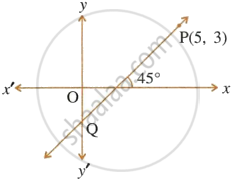Advertisements
Advertisements
Question
Find k, if R(1, –1), S (–2, k) and slope of line RS is –2.
Solution
Slope of line RS is –2
Slope of RS will be
\[\frac{y_2 - y_1}{x_2 - x_1} = \frac{k - \left( - 1 \right)}{- 2 - 1} = \frac{k + 1}{- 3} = - 2\]
\[ \Rightarrow k + 1 = 6\]
\[ \Rightarrow k = 5\]
APPEARS IN
RELATED QUESTIONS
The slope of a line joining P(6, k) and Q(1 – 3k, 3) is `1/2`. Find:
- k.
- mid-point of PQ, using the value of ‘k’ found in (i).
Find the slope of the line perpendicular to AB if : A = (0, −5) and B = (−2, 4)
Find the slope of the line perpendicular to AB if : A = (3, −2) and B = (−1, 2)
Find x, if the slope of the line joining (x, 2) and (8, −11) is `−3/4`.
The line through P(5, 3) intersects y-axis at Q.
- Write the slope of the line.
- Write the equation of the line.
- Find the co-ordinates of Q.

Find the slope and the inclination of the line AB if : A = `(0, - sqrt(3))` and B = (3, 0)
Find the slope of the line which is perpendicular to `x - y/2 + 3 = 0`
The lines represented by 4x + 3y = 9 and px – 6y + 3 = 0 are parallel. Find the value of p.
Find the value of k for which the lines kx – 5y + 4 = 0 and 5x – 2y + 5 = 0 are perpendicular to each other.
The ordinate of a point lying on the line joining the points (6, 4) and (7, –5) is –23. Find the coordinates of that point.
Determine whether the given point is collinear.
\[P\left( 1, 2 \right), Q\left( 2, \frac{8}{5} \right), R\left( 3, \frac{6}{5} \right)\]
Show that points P(1, –2), Q(5, 2), R(3, –1), S(–1, –5) are the vertices of a parallelogram.
Find the slope of a line passing through the given pair of points (3,7) and (5,13)
Write the equation of a line passing through the point P (0,6) and having slope 6/7.
The line through A (- 2, 3) and B (4, b) is perpendicular to the line 2a – 4y = 5. Find the value of b.
If A(6, 1), B(8, 2), C(9, 4) and D(7, 3) are the vertices of `square`ABCD, show that `square`ABCD is a parallelogram.
Solution:
Slope of line = `("y"_2 - "y"_1)/("x"_2 - "x"_1)`
∴ Slope of line AB = `(2 - 1)/(8 - 6) = square` .......(i)
∴ Slope of line BC = `(4 - 2)/(9 - 8) = square` .....(ii)
∴ Slope of line CD = `(3 - 4)/(7 - 9) = square` .....(iii)
∴ Slope of line DA = `(3 - 1)/(7 - 6) = square` .....(iv)
∴ Slope of line AB = `square` ......[From (i) and (iii)]
∴ line AB || line CD
∴ Slope of line BC = `square` ......[From (ii) and (iv)]
∴ line BC || line DA
Both the pairs of opposite sides of the quadrilateral are parallel.
∴ `square`ABCD is a parallelogram.
